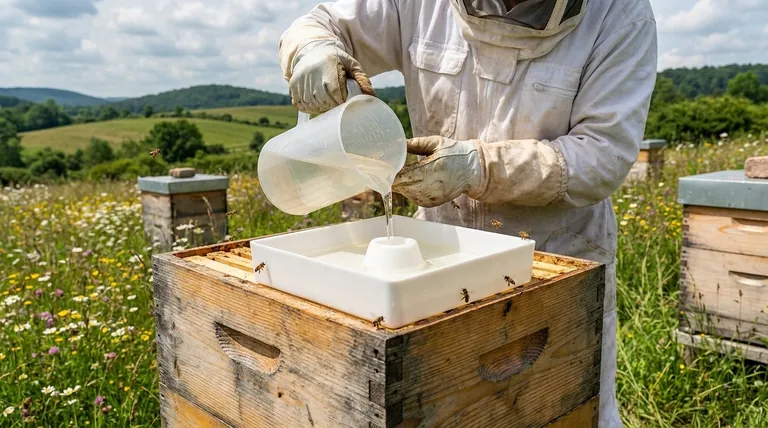Feeding sugar syrup is a critical management tool for ensuring the health and survival of a honey bee colony. Beekeepers provide this nectar substitute for three primary reasons: to stimulate colony growth and brood production, to sustain the bees during a period of nectar shortage (a "dearth"), and to help the colony build adequate food stores to survive the winter.
At its core, feeding sugar syrup is not about replacing natural nectar, but about providing a strategic high-energy supplement during vulnerable periods. It's a targeted intervention to bridge nutritional gaps when the environment cannot support the colony's needs.

Why a Colony Needs Supplemental Feeding
Stimulating Colony Growth
For a new or weakened colony, a steady supply of food is essential for rapid growth. Sugar syrup acts as a powerful stimulant, mimicking a natural nectar flow.
This perceived abundance encourages the queen bee to increase her egg-laying rate, leading to a larger population of worker bees. Much like an infant formula, the syrup provides the high-energy carbohydrates necessary to grow a strong colony that can soon forage for itself.
Surviving a Nectar Dearth
A "nectar dearth" is a period when few flowers are blooming, depriving bees of their natural food source. This can happen during a hot, dry summer or other unfavorable weather conditions.
During a dearth, feeding sugar syrup provides the essential energy the colony needs to survive. It prevents starvation and keeps the bees from consuming the honey stores they will need for the winter.
Building Critical Winter Stores
A honey bee colony requires a substantial amount of stored honey to generate heat and survive the cold winter months when they cannot fly.
If a beekeeper has harvested honey or if the colony was unable to gather enough nectar, feeding syrup becomes essential. The bees process the syrup and store it in the comb, effectively replacing the honey stores they need to make it through winter.
Understanding the Trade-offs and Best Practices
Syrup Is Not a Perfect Substitute
While sugar syrup provides critical carbohydrates, it is not a complete food. It lacks the complex enzymes, proteins, and micronutrients found in natural floral nectar.
Prolonged reliance on syrup without access to natural pollen (their protein source) can negatively impact colony health. It should always be viewed as a supplement, not a replacement.
Choose the Right Feeding Method
There are several ways to provide syrup, including top feeders, frame feeders, and gravity (or entrance) feeders.
Each method has its own advantages. For example, internal feeders like frame feeders can reduce the risk of attracting bees from other colonies, a phenomenon known as "robbing," which can devastate a weak hive.
Avoid Feeding During Honey Production
Never feed sugar syrup when you have honey supers on the hive that you intend to harvest for human consumption.
The bees will store the syrup in the honeycomb just like nectar, and this will result in a product that cannot legally or ethically be called pure honey. Feeding should cease well before honey collection begins.
Making the Right Feeding Decision
By understanding your colony's specific situation, you can use sugar syrup to achieve distinct goals.
- If your primary focus is establishing a new colony: Feed a 1:1 syrup (one part sugar to one part water) to simulate a spring nectar flow and encourage rapid population growth.
- If your primary focus is bridging a summer dearth: Provide syrup to prevent starvation and ensure the colony remains strong enough to forage when flowers bloom again.
- If your primary focus is preparing for winter: Feed a thicker syrup after the final honey harvest to help bees quickly build up the heavy stores they need to survive the cold.
Ultimately, knowing when and why to feed is the key to managing a resilient and thriving honey bee colony.
Summary Table:
| Purpose of Feeding | Key Benefit | Common Syrup Ratio |
|---|---|---|
| Stimulate Growth | Encourages queen to lay more eggs, boosting population. | 1:1 (Sugar:Water) |
| Survive a Dearth | Prevents starvation when natural nectar is unavailable. | 1:1 or 2:1 |
| Build Winter Stores | Ensures colony has enough food to survive the cold months. | 2:1 (Sugar:Water) |
Ensure your apiary's success with the right equipment. Feeding is just one part of effective hive management. HONESTBEE supplies commercial apiaries and beekeeping equipment distributors with high-quality, durable supplies through our wholesale-focused operations. From feeders and hive tools to protective gear, we provide everything you need to support strong, productive colonies.
Contact HONESTBEE today to discuss your wholesale needs and how our reliable equipment can contribute to your operation's resilience and profitability.
Visual Guide

Related Products
- HONESTBEE Professional Hive Top Bee Feeder Feeding Solution
- HONESTBEE Round Hive Top Bee Feeder for Syrup
- Rapid Bee Feeder White Plastic 2L Round Top Feeder for 8 or 10-Frame Bee Hives
- HONESTBEE Entrance Bee Feeder Professional Hive Nutrition Solution for Beekeeping
- Classic Boardman Entrance Bee Feeder Hive Front Feeding Solution
People Also Ask
- What should be done with feeders and equipment after feeding bees? Essential Steps for Apiary Health
- How is the plywood floor fitted into the hive-top feeder? Ensure Longevity with a Floating Floor Design
- What is the best way to top feed bees? A Safe, High-Volume Feeding Solution for Your Apiary
- Do I need an inner cover with a hive top feeder? Optimize Your Hive Setup for Healthy Bees
- What is a top feeder for bees? Maximize Colony Health with Efficient Feeding



















